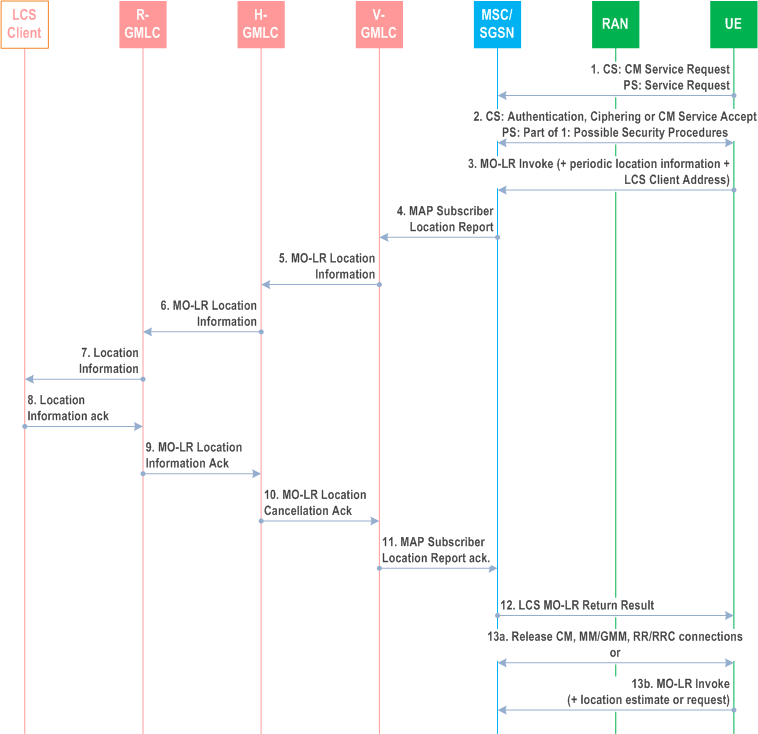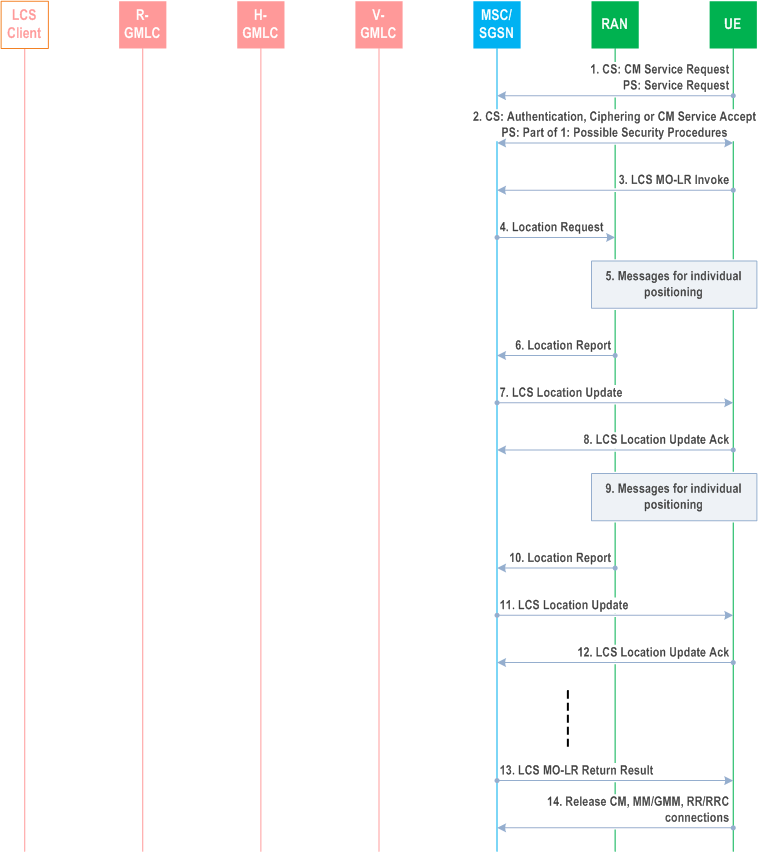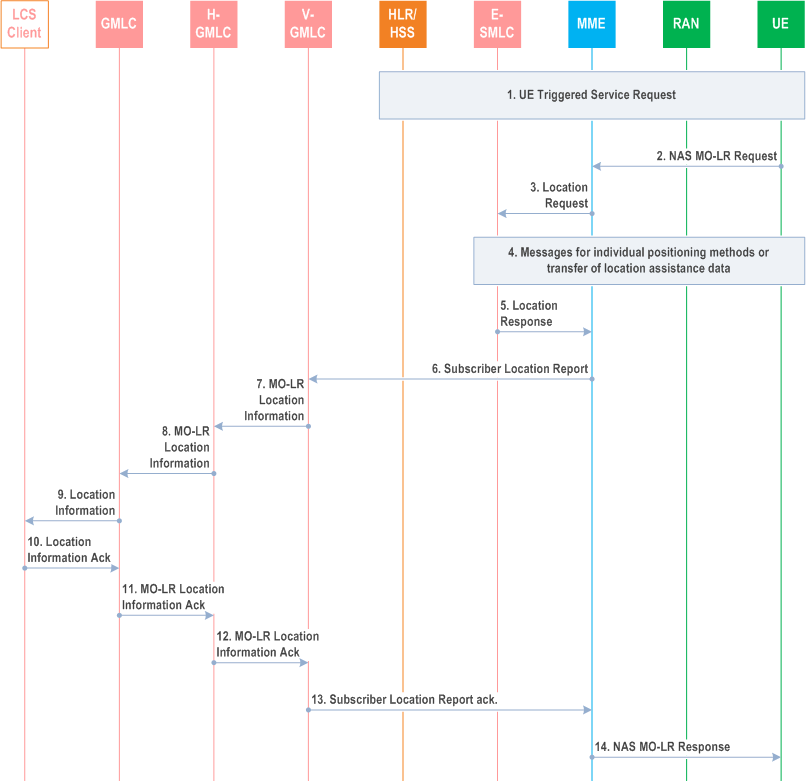Content for TS 23.271 Word version: 18.0.0
1…
5…
6…
6.2…
7…
8…
9…
9.1.1A…
9.1.2…
9.1.5…
9.1.6…
9.1.8…
9.1.9…
9.1.12…
9.1.13…
9.1.15…
9.1.19…
9.2…
9.2.2…
9.2.3…
9.3…
9.4…
9.5…
9.6…
10…
11…
A…
B…
E
F…
9.2.3 MO-LR Request for Periodic Location Transfer to a Third Party
9.2.4 MO-LR Request for Periodic Self Location
9.2.5 WLAN UE Originated Procedure in I-WLAN
9.2.6 Mobile Originating Location Request, EPC (EPC-MO-LR)
9.2.6.1 Location Preparation Procedure
9.2.6.2 Positioning Measurement Establishment Procedure
9.2.6.3 Location Calculation and Release Procedure
...
...
9.2.3 MO-LR Request for Periodic Location Transfer to a Third Party |R7| p. 127
The following procedure shown in Figure 9.8a allows a UE to instigate a periodic transfer of location to an external LCS client. The procedure would be executed once after which it would be followed by the procedure described in clause 9.1.12.2.

Step 1) to 2.
If the UE is in idle mode, the UE requests a radio connection setup and sends a CM Service Request indicating a request for call independent supplementary service to the VMSC/MSC server via RAN (CS domain). If the UE is in dedicated mode, the UE sends a CM Service Request on the already established radio connection. The VMSC/MSC server instigates authentication and ciphering if the UE was in idle mode or returns a CM Service Accept if the UE was in dedicated mode.
For PS domain, in UMTS, if the UE is in idle mode, the UE requests a PS signalling connection and sends a Service Request indicating signalling to the SGSN via RAN. If the UE already has PS signalling connection, the UE does not need to send the Service Request. Security functions may be executed. These procedures are described in TS 23.060. In GSM this signalling step is not needed.
Step 3.
The UE sends an LCS MO-LR Invoke for periodic transfer of location to a third party LCS client. The UE shall include the periodic location related parameters (reporting interval and total number of reports). The UE shall also include the identity of the LCS client and may include the address of the GMLC through which the LCS client can be accessed. The UE may include a request for use of MO-LR Short Circuit (e.g. if the UE supports UE based positioning). The absence of an H-GMLC assigned LDR reference number in this case indicates that the request has not yet been authorized.
Step 4) to 7.
The request to initiate periodic location shall be transferred in succession from the MSC/SGSN to the V GMLC, H-GMLC, R-GMLC serving the LCS client and finally may be transferred to the LCS client. The periodic location parameters (reporting interval and number of reports) are included as well as any request for use of MO-LR Short Circuit. Any entity (MSC/SGSN, V GMLC, H GMLC, R GMLC and, if notified, LCS Client) is enabled to accept or refuse the request. In addition, if the request was accepted, any entity is free to reject use of MO-LR Short Circuit. If the request is accepted, a LDR reference number is assigned by the H GMLC.
Step 8) to 11.
The response transferred back to the MSC/SGSN shall indicate acceptance or rejection and whether MO LR short circuit (if requested) has been accepted. The response also includes the LDR reference number assigned by the H-GMLC and the H-GMLC address. The H-GMLC may include in the response a list of PLMNs and possibly associated radio access technologies, either prioritized or non-prioritized, in which subsequent location estimates must be obtained and an indication for each PLMN (and possibly each associated radio access technology) of whether periodic location in the RAN is supported. If no list is included, subsequent locations are restricted to the current serving PLMN only
Step 12.
The MSC/SGSN returns the result of the request to the UE in a LCS MO-LR Return Result message including the LDR reference number, the H-GMLC address any reporting PLMN list and an indication whether MO-LR Short Circuit is allowed (if requested by the UE in step 3.
Step 13a.
The UE may instigate release of the CM, MM/GMM and radio connections - e.g. if the request was rejected or if the MSC/SGSN provided a list of PLMNs that did not include the serving PLMN (or if the serving PLMN was included in a prioritized list with a lower priority). Assuming the request was accepted, the UE may then initiate reporting of the first location estimate using the procedure described in clause 9.1.12.2 and beginning at step 1.
Step 13b.
If the request was accepted and the serving PLMN can be used for subsequent location, the UE may initiate reporting of the first location estimate by sending an MO-LR request indicating transfer of location to the LCS Client using the procedure described in clause 9.1.12.2 and beginning at step 3.
9.2.4 MO-LR Request for Periodic Self Location |R7| p. 129
The following procedure shown in Figure 9.8b allows an UE to request its own location periodically if the RAN serving the target UE supports periodic location. This procedure is useful if a UE only supports UE-assisted positioning or has no positioning capability.

Step 1) to 2.
If the UE is in idle mode, the UE requests a radio connection setup and sends a CM Service Request indicating a request for call independent supplementary service to the VMSC/MSC server via RAN (CS domain). If the UE is in dedicated mode, the UE sends a CM Service Request on the already established radio connection. The VMSC/MSC server instigates authentication and ciphering if the UE was in idle mode or returns a CM Service Accept if the UE was in dedicated mode.
For PS domain, in UMTS, if the UE is in idle mode, the UE requests a PS signalling connection and sends a Service Request indicating signalling to the SGSN via RAN. If the UE already has PS signalling connection, the UE does not need to send the Service Request. Security functions may be executed. These procedures are described in TS 23.060. In GSM this signalling step is not needed.
Step 3.
The UE sends an MO-LR invoke requesting periodic self location. The request includes the required QoS, the periodic location interval and the total number of reports.
Step 4.
The MSC/SGSN sends a location request to the RAN containing the QoS and periodic location information received in step 3.
Step 5.
RAN determines the positioning method and instigates the particular message sequence for this method, as specified in UTRAN Stage 2, TS 25.305 and GERAN Stage 2, TS 43.059.
Step 6.
When a location estimate best satisfying the requested QoS has been obtained, RAN returns it to the MSC/SGSN.
Step 7.
The MSC/SGSN sends an LCS Location Update invoke to the UE containing the first location estimate.
Step 8.
The UE acknowledges receipt of the first location estimate. If the UE wished to cancel the periodic location procedure at that point, an additional parameter (e.g. flag or cause value) is included in this message.
Step 9-12.
As steps 5-8 for the second location estimate and thereafter repeated at the periodic location interval until the total number of reports is attained.
Step 13.
After the final location estimate has been transferred in step 12, the MSC/SGSN returns an MO-LR return result to the UE to indicate completion of the periodic location request in step 3. As an implementation option, the final location estimate may be returned in the MO-LR return result in step 13 rather than in an LCS Location Update in step 11.
Step 14.
The MSC/SGSN instigates clearing of the CM, MM/GMM and radio connections.
9.2.5 WLAN UE Originated Procedure in I-WLAN |R7| p. 131
This procedure is applicable to a UE connected to I-WLAN defined in TS 23.234 and it is no longer maintained.
Figure 9.8c describes the MO-LR procedure for LCS for I-WLAN.

Step 1.
The WLAN UE selects a WLAN AN and establishes the WLAN connection and is authenticated in I-WLAN. The tunnel is established with between WLAN UE and one of PDGs in PLMN.
Step 2.
WLAN UE initiates positioning procedure by establishing a so called user plane connection with the GMLC/SLP and shall use the OMA SUPL mechanism specified by OMA (OMA AD SUPL [38], OMA TS ULP [39]) to transport location related assistance data and location information between the UE and GMLC/SLP. The UE may receive assistance data and determine its own location and send its location information to the GMLC/SLP or the UE sends measurement results to the GMLC/SLP. In case GMLC/SLP determines the location of the UE, the GMLC/SLP shall send the location information to the WLAN UE. The UE may also send the identifier of the access node (e.g., MAC address of the AP) to the GMLC and GMLC, possibly using an external database, maps this location identifier to the corresponding geographical information, e.g. coordinates or street address and returns the result to the UE.
Step 3.
The location information obtained is transferred to external LCS client if requested by WLAN UE. The estimated position of a WLAN UE can be stored in the GMLC after WLAN UE originated positioning procedure for future uses subject to the privacy settings of the WLAN UE. If there is an LCS request from an external LCS Client, the stored location information can be delivered to the external LCS client if the stored location information satisfies LCS QoS requested.
9.2.6 Mobile Originating Location Request, EPC (EPC-MO-LR) |R9| p. 132
The following procedure shown in Figure 9.8d allows an UE to request either, its own location and optionally, velocity or location assistance data. Location assistance data may be used subsequently by the UE to compute its own location throughout an extended interval using a mobile based position method. The EPC MO LR may be used to request GNSS assistance data. The procedure may also be used to enable an UE to request that its own location be sent to an external LCS client.

9.2.6.1 Location Preparation Procedure p. 132
Step 1.
If the UE is not using Control Plane CIoT EPS Optimisation and if the UE is in ECM-IDLE state, the UE performs a UE triggered service request as defined in TS 23.401 in order to establish a signalling connection with the MME and assign a specific eNodeB.
If the UE is using Control Plane CIoT EPS Optimisation, procedures for Mobile Originated Data Transport in Control Plane CIoT EPS optimisation as defined in TS 23.401 are performed by the UE to establish a signalling connection with the MME.
Step 2.
The UE sends a NAS PDU containing an MO-LR Request inside an RRC UL Information Transfer message to the eNodeB. The MO-LR Request may optionally include an LPP positioning message. The eNodeB forwards the MO-LR Request (including any embedded LPP message) to the MME inside an S1AP Uplink NAS Transport message. Different types of location services can be requested: location estimate of the UE, location estimate of the UE to be sent to an external LCS client or location assistance data. If the UE is requesting its own location or that its own location be sent to an external LCS client, this message carries LCS requested QoS information (e.g. accuracy, response time, LCS QoS Class), the requested maximum age of location and the requested type of location (e.g. "current location", "current or last known location"). If the UE is requesting that its location be sent to an external LCS client, the message shall include the identity of the LCS client and may include the address of the GMLC through which the LCS client should be accessed. In addition, a Service Identity indicates which MO-LR service of the LCS Client is requested by the UE may be included. The message also may include a pseudonym indicator to indicate a pseudonym should be assigned by the network and transferred to the LCS Client as the UE's identity. If the UE is instead requesting location assistance data, the embedded LPP message specifies the type of assistance data and the positioning method for which the assistance data applies. For an LCS EPC-MO-LR requesting location transfer to an external LCS Client, the MME shall assign a GMLC address, i.e. V-GMLC address, which is stored in the MME. If a V-GMLC address is not available, the MME may reject the location request. The MME verifies the subscription profile of the UE and decides if the requested service is allowed or not.
Step 3.
The MME selects a E-SMLC as described in clause 6.3.13 and sends a Location Request message to the selected E-SMLC. The Location Request message conveys any embedded LPP message in the MO-LR Request. Once an MME has selected an E-SMLC it must continue to use that E-SMLC for the duration of the session. The Location Request message indicates whether a location estimate or location assistance data is requested. If the UE's location is requested, the message also includes the requested QoS. If location assistance data is requested, the embedded LPP message will convey the requested types of location assistance data. The message carries also other location parameters received in the MO-LR Request message, the current cell identity obtained from S1-AP message that carries the NAS MO-LR Request, and the UE capability to support LPP. The message also indicates RAT type and/or coverage level if applicable.
9.2.6.2 Positioning Measurement Establishment Procedure p. 133
Step 4.
If the UE is requesting its own location, the actions described in clause 9.3a are performed. If the UE is instead requesting location assistance data, the E-SMLC transfers this data to the UE as described in clause 9.3a.1. The E-SMLC determines the exact location assistance data to transfer according to the type of data specified by the UE, the UE location capabilities and the current cell.
NB-IoT UEs may perform measurements for some positioning methods only when in ECM-IDLE state. An E-SMLC that is aware of this (e.g. from an indication sent by the UE) may allow additional response time to the UE (e.g. in the QoS) to obtain the measurements. An MME that is aware of this (e.g. from the UE access type) may also allow additional time for a location session to complete.
9.2.6.3 Location Calculation and Release Procedure p. 133
Step 5.
When a location estimate best satisfying the requested QoS has been obtained or when the requested location assistance data has been transferred to the UE, the E-SMLC returns a Location Response to the MME with an indication whether the obtained location estimate satisfies the requested accuracy or not. This message carries the location estimate if this was obtained. If a location estimate was not successfully obtained, or if the requested location assistance data could not be transferred successfully to the UE, a failure cause is included in the Location Response.
Step 6.
If the UE did not request transfer of its location to an external LCS Client in step 2, steps 6 to 13 are skipped. Otherwise, if the location estimate was successfully obtained, the MME shall send a Subscriber Location Report to the V-GMLC assigned in the step 2, carrying the MSISDN/IMSI of the UE, the event causing the location estimate (EPC-MO LR) and the location estimate, its age, obtained accuracy indication and the LCS QoS Class requested by the target UE. In addition, the Subscriber Location Report may include the pseudonym indicator, the identity of the LCS Client, the GMLC address and the Service Identity specified by the UE, if available.
Step 7.
This step is the same as step 7 for a PS-MO-LR in clause 9.2.2.3.
Step 8.
This step is the same as step 8 for a PS-MO-LR in clause 9.2.2.3.
Step 9.
This step is the same as step 9 for a PS-MO-LR in clause 9.2.2.3.
Step 10.
This step is the same as step 10 for a PS-MO-LR in clause 9.2.2.3.
Step 11.
This step is the same as step 11 for a PS-MO-LR in clause 9.2.2.3.
Step 12.
This step is the same as step 12 for a PS-MO-LR in clause 9.2.2.3.
Step 13.
If the V-GMLC receives the MO-LR Location Information Acknowledgement from the H-GMLC, the V-GMLC shall record charging information both for the UE and inter-working revenue charges and send the Subscriber Location Report Acknowledgement to the MME, carrying the information specifies whether the location estimate of the UE has been handled successfully by the identified LCS Client, and if not success, the corresponding error cause obtained in step 12.
If the V-GMLC receives the Subscriber Location Report from the MME and it is not required to send to any LCS Client, the V-GMLC shall record charging information for the UE and response the Subscriber Location Report Acknowledgement to the MME.
Step 14.
The MME returns a NAS MO-LR Response message to the UE carrying any location estimate requested by the UE including the indication received from E-SMLC whether the obtained location estimate satisfies the requested accuracy or not, or an indicator whether a location estimate was successfully transferred to the identified LCS client. If the location estimate was successfully transferred to the identified LCS Client, the MO-LR Response message shall specify whether the location estimate of the UE has been handled successfully by the identified LCS Client, and if not, the corresponding error cause obtained in step 13. The MME may record charging information.